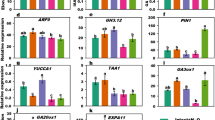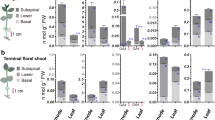Abstract
Gibberellins (GAs) regulate petunia corolla pigmentation and elongation. To study this hormone's effect at the molecular level, we used the tomato gast1 gene as a probe to isolate a gibberellin-induced gene (gip) from petunia corollas. The deduced sequence of gip exhibited 82% identity with GAST1 protein and contained a short, highly hydrophobic N-terminal region. High levels of gip expression were detected in elongating corollas and young stem internodes. When detached corollas were grown in vitro in sucrose medium, gip expression was strongly induced by gibberellic acid (GA3). GA3-induced gip expression in corollas was inhibited by abscisic acid (ABA). The expression of the gene was also induced by GA3 in detached young stem segments. Sucrose was not essential for GA-induced gip expression in corollas but enhanced its effect. In stems, on the other hand, sucrose inhibited the effect of the hormone. The results of the present work support the possible role of gip in GA-induced corolla and stem elongation.
Similar content being viewed by others
References
Ben-Nissan G, Weiss D: Developmental and hormonal regulation of a triosephosphate isomerase gene in petunia corollas. J Plant Physiol 147: 58–62 (1995).
Halevy AH, Mayak S: Senescence and post harvest physiology of cut flowers Part II. In: Janick J (ed) Horticultural Reviews, vol. 3, pp. 59–143. Avi Publishing Co., West Point, CT (1981).
Herzog M, Dorne AM, Grellet F: GASA, a gibberellin-regulated gene family from Arabidopsis thaliana related to the tomato GAST1 gene. Plant Mol Biol 27: 743–752 (1995).
Hooley R: Gibberellins: perception, transduction and responses. Plant Mol Biol 26: 1529–1555 (1994).
Huttly AK, Phillips AL: Gibberellin-regulated plant genes. Physiol Plant 95: 310–317 (1995).
Izhaki A, Shoseyov O, Weiss D: Temporal, spatial and hormonal regulation of the S-adenosylmethionine synthetase gene in petunia. Physiol Plant, in press (1996).
Jang JC, Sheen J: Sugar sensing in higher plants. Plant Cell 6: 1665–1679 (1994).
Katsumi M, Ishida K: Gibberellin control of cell elongation. In: Takahashi N, Phinney BO, MacMillan J (eds) Gibberellins, pp. 211–219. Springer-Verlag, New York (1991).
Kinet JM, Sachs RM, Bernier G: The Physiology of Flowering, vol. III: The Development of Flowers, pp. 123–177. CRC Press, Boca Raton, FL (1985).
Koes RE, Spelt CE, Reif HJ, van der Elsen PJM, Veltkamp E, Mol JNM: Floral tissue of Petunia hybrida (V30) expresses only one member of the chalcone synthase multigene family. Nucl Acids Res 14: 5229–5239 (1986).
Kroon J, Souer E, de Graaff A, Xue Y, Mol J, Koes R: Cloning and structural analysis of the anthocyanin pigmentation locus Rt of Petunia hybrida: characterization of insertion sequences in two mutant alleles. Plant J 5: 69–80 (1994).
Maniatis T, Fritsch EF, Sambrook J: Molecular Cloning: A Laboratory Manual. Cold Spring Harbor Laboratory. Cold Spring Harbor, NY (1982).
Martin C, Gerats T: Control of pigment biosynthesis genes during petal development. Plant Cell 5: 1253–1264 (1993).
Mendu N, Silflow CD: Elevated levels of tubulin transcripts accompany the GA3-induced elongation of oat internode segments. Plant Cell Physiol 34: 973–983 (1993).
Mur L: Characterization of member of the myb gene family of transcription factors from Petunia hybrida. Ph.D. thesis, Vrije Universiteit, Amsterdam, Netherlands (1995).
Phillips AL, Huttly AK: Cloning of two gibberellin-regulated cDNAs from Arabidopsis thaliana by subtractive hybridization: expression of the tonoplast water channel, γ-TIP, is increased by GA3. Plant Mol Biol 24: 603–615 (1994).
Potter I, Fry SC: Changes in xyloglucan endotransglycosylase (XET) activity during hormone-induced growth in lettuce and cucumber hypocotyls and spinach cell suspension cultures. J Exp Bot 45: 1703–1710 (1994).
Shi L, Gast RT, Gopalraj M, Olszewski NE: Characterization of a shoot-specific, GA3 and ABA-regulated gene from tomato. Plant J 2: 153–159 (1992).
Taylor BH, Scheuring CF: A molecular marker for lateral root initiation: the RSI-1 gene of tomato (Lycopersicon esculentum Mill) is activated in early lateral root primordia. Mol Gen Genet 243: 148–157 (1994).
Vainstein A, Sharon R: Biogenesis of petunia and carnation corolla chloroplasts: changes in the abundance of nuclear and plastid-encoded photosynthesis-specific gene products during flower development. Physiol Plant 89: 192–198 (1993).
Vanderhoef LN, Stahl CA: Separation of two responses to auxin by means of cytokinin inhibition. Proc Natl Acad Sci USA 72: 1822–1825 (1975).
van Tunen AJ, Koes RE, Spelt CE, van der Krol AR, Stuitje AR, Mol JNM: Cloning of the two chalcone flavanone isomerase genes from Petunia hybrida: coordinate, light-regulated and differential expression of flavonoid genes. EMBO J 7: 1257–1263 (1988).
Weiss D, Halevy AH: Stamens and gibberellin in the regulation of corolla pigmentation and growth in Petunia hybrida. Planta 179: 89–96 (1989).
Weiss D, van Blokland R, Kooter JM, Mol JNM, van Tunen AJ: Gibberellic acid regulates chalcone synthase gene transcription in the corolla of Petunia hybrida. Plant Physiol 98: 191–197 (1992).
Weiss D, van der Luit A, Knegt E, Vermeer E, Mol JNM, Kooter JM: Identification of endogenous gibberellins in petunia flower, induction of anthocyanin biosynthetic gene expression and the antagonistic effect of abscisic acid. Plant Physiol 107: 695–702 (1995).
Weiss D. van der Luit AH, Kroon JTM, Mol JNM, Kooter JM: The petunia homologue of the Antirrhinum majus candi and Zea mays A2 flavonoid genes; homology to flavonone 3-hydroxylase and ethylene-forming enzyme. Plant Mol Biol 22: 893–897 (1993).
Weiss D, van Tunen AJ, Halevy AH, Mol JNM, Gerats AGM: Stamens and gibberellic acid in the regulation of flavonoid gene expression in the corolla of Petunia hybrida. Plant Physiol 94: 511–515 (1990).
Author information
Authors and Affiliations
Rights and permissions
About this article
Cite this article
Ben-Nissan, G., Weiss, D. The petunia homologue of tomato gast1: transcript accumulation coincides with gibberellin-induced corolla cell elongation. Plant Mol Biol 32, 1067–1074 (1996). https://doi.org/10.1007/BF00041390
Received:
Accepted:
Issue Date:
DOI: https://doi.org/10.1007/BF00041390




